
Eugenija: "I lived nearby.
Eugenija: "I lived nearby. I crossed the street, where there currently stands a Russian school. That’s how I walked into the cemetery. There was a mosque there, benches, the backyard of the school. Later they started dismantling everything there, diggings began, excavators came and they wouldn’t let us walk there anymore. I would only walk near the mosque and with the trolley I would then go to the central path. I saw that they were dismantling it, but from far away. That side was fixed just until the central path. Just as you walked in through the main entrance, on the right side there was a row of crosses made out of cement for soldiers. They were for Lithuanian volunteers. After a while they were all dismantled, replaced by benches and there sat “grannies” who jabbered. When they were dismantling the other side, near the orthodox church, you couldn’t see a thing. The dismantling there was grave. You could go to the marketplace by Vytautas avenue. I used to see a lot of people there, that would go on walks. Although I live really near, I just need to cross the street, this place is not a park to me even now. It’s a cemetery. I can’t be there. I get a bad feeling. One time an extrasens (medium) came to the city, she was showed around it. Although I don’t know why. the extrasens lady said that this place was no good. There were a lot of dead peoples’ bodies which weren’t transferred. There’s a bad aura. My son feels the same. He doesn’t take walks there and doesn’t walk the dogs. When I used to go on walks there, the mausoleum of Darius and Girėnas was still there. I was down there to take a look at it. But it was empty, the graves were no longer there. I saw the graves of Darius and Girėnas in the institute.
Read more
Eugenija: "I remember, when they destroyed Stalin’s monument.
Eugenija: "I remember, when they destroyed Stalin’s monument. The windows of our apartment were facing the appendix. From the window I could say that the traffic had been stopped, people couldn’t walk across the street, nor go down the street of Parodos. A truck arrived. It was dark, a lot of police. I saw how they threw ropes on it, pulled them and demolished it. The leftover pieces were put in the truck. A policeman was even standing near the gates of our yard." (2019)
Read more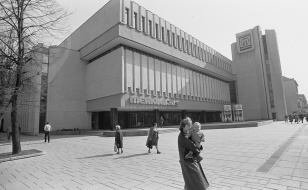
K.
*K. Laurinaitytė: *I had been visiting Merkurijus since very young days. It was like one of the monuments of Kaunas. That building had something to it. It was more beautiful on the exterior than the interior. It was the first place, where my mother allowed me to walk with friends without supervision. (2014)
Read more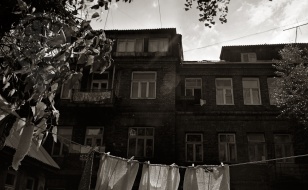
Eglė: Hens running across the yard, pigs being farmed behind the house and the old horse of Kaunas silently sitting in the garage...
*Eglė:* Hens running across the yard, pigs being farmed behind the house and the old horse of Kaunas silently sitting in the garage... It is a description of a casual rural household after World War II, of one of the buildings located in Nemunas Street. Described as the Red-light district during the interwar period, the street was many times called the Venice of Kaunas as well, as the overflowing river used to flood the street. Despite the street being unknown to many tourists, and a few of who live in Kaunas since birth having been there, locals are full of memories. It is known that since the 1870’s, the property of land belonged to the town dweller Chaim Gidoni and after his death in 1876; to his family’s generations. In 1900, two-storey buildings (now Nemunas St. 14 and 14B) of red brick masonry were built. Later, in 1927 the property was sold to Benjamin Gruzdas, who was the owner of a jewellery store in Laisvės Avenue and the official provider of Omega watches. The oldest residents remember themselves being children, sitting in the house and watching playfully the overflowing river. Together with floating giant floes (heet of floating ice) the river used to flood almost up to the windows of the ground floor of the Nemunas St. 14B building. Ms. Elena was one of these children, who grew up listening to the clamour of children’s voices and saw adults organising birthday celebrations with food, music and dances until sunrise. However, not all of the memories cause nostalgia. According to Mr. Levas, several tragic accidents have happened: during one of the floods, a woman drowned when she accidentally fell into the basement, a German military officer jumping out from the balcony of building 14B, and one woman burned alive in the fire of a storehouse where she lived. Another local resident, Romas, remembers the times when several families had to live in one small apartment. Once, his mother hosted two students, who protested against the Soviet Union government by sewing so called “granny” pants out of the union’s flag and hanging it on the fence next to the parterre. These past stories allow people to feel the spirit of the street and re-live every moment experienced by former residents of Nemunas street.
Read more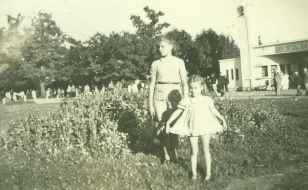
1 photographLili Kristina Vaičekauskaitė-Čepauskienė (2014): Me and my mother in the Oakwood Park in1947.
1 photograph *Lili Kristina Vaičekauskaitė-Čepauskienė (2014):* Me and my mother in the Oakwood Park in1947. A man next to us is my father's coworker and my father is behind the camera.
Read more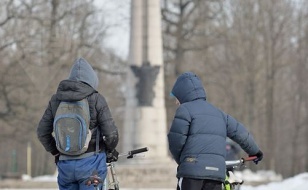
The funniest part was to spin circles around the monument with my Nikon, which was used but still great.
The funniest part was to spin circles around the monument with my Nikon, which was used but still great. I brought it back from a trip. Before leaving, I used half a film taking photos with my Zenit camera, capturing the monument which had not been fully built yet, and in June, I used the rest of the film in my new camera to capture the installation the sculpture. I was in time to the see the test installation of the sculpture, and later the actual procedure. When the team of construction workers made sure that everything was OK, some of them even started to pose, as if they gained some significant award. It somewhat reminded of a different photo, the completion of the railway that connected the Western and the Eastern banks... It was probably the first time when I saw all the benches in Sporto Alėja (Sport’s Avenue) occupied: people watched the installation of the sculpture as some show. The monument was uncovered on 17 July 1993 and it was probably the largest rally-type even in Kaunas after the restoration of Independence.
Read more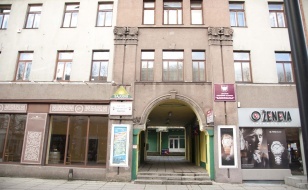
Music club Senas Stalčius (Laisvės ave.
Music club Senas Stalčius (Laisvės ave. 46a) was open for several years since 1995. The club was established in the building of cinema Laisvė (called Forum during the Inter-War period). It is a great example of a certain type of architecture in Laisvės Alėja: a public building designed in the internal yard.
Read more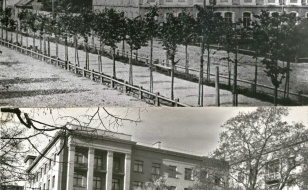
Alvydas Vaitkevičius: I am sending several photos by a famous photographer from the Soviet times, Stanislovas Lukošius which he gave me before he passed away.
*Alvydas Vaitkevičius: *I am sending several photos by a famous photographer from the Soviet times, Stanislovas Lukošius which he gave me before he passed away. Photos feature explanations by Stanislovas Lukošius himself. He had a phenomenal memory and knew about the past of Kaunas in great detail. He wrote the texts himself, even though he was almost blind, so they are not easy to read... Almost 30 years ago, I got an opportunity to speak with him at his home. At that time, he had been blind for maybe 10 years and could not manage the archive of his photos and negatives without help. My son, who was then around 12 helped him at that time. Lukošius was a great patriot of Lithuania and greatly influenced my son's attitude towards history. Lukošius gave these and other photos to my son, but these are of the best quality. Maybe later I will find more... (2014)
Read more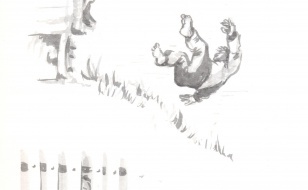
Siegfried: “Just at the outskirts of Kaunas, I was dug up by locomotive firemen and picked up like some kitten.
*Siegfried:* “Just at the outskirts of Kaunas, I was dug up by locomotive firemen and picked up like some kitten. It was the spring of 1947, the weather was still cold. The men asked me in German: “How did you end up here?” I told them: “I want nach Litauen, Kowno, Brot holen. To Lithuania, Kaunas, bring bread back to my mother.” The train stopped in front of Nemunas and the railway bridge. The main said: “You would not cross this bridge. We would cross it, bring you over and leave you in Kaunas.” And that was what they did. I saw clean, neatly dressed people walking around. The city and the station were full. I thought to myself, that I was probably dead, because my mother told me that we were “close to our graves”, and if people died, both children and adults, they went straight to heaven.” And when in Kaunas I saw one Russian and then another one, I woke up from that dream. My new life had started. When I started writing a book, I told people and to myself that this has been my second homeland. I was in Lithuania for the second time.” (2018 m.)
Read more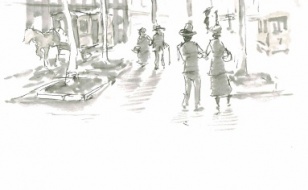
Asija: “In the evenings, Laisvės Avenue was full of people.
*Asija*: “In the evenings, Laisvės Avenue was full of people. Families would go for a walk. It was a magnificent tradition. Lithuanian, Jewish and Russian families were walking in the avenue. The oldest members of the family would be walking in front of everyone else; parents following them and lastly a bunch of children were running after them. Slowly, constantly greeting each other, people passed through Laisvės Avenue and returned home. Women had to have a small handbag and a hat.” (2017).
Read moreAlvydas Vaitkevičius: A note on the monument of Salomėja Nėris: I remember it standing there.
*Alvydas Vaitkevičius*: A note on the monument of Salomėja Nėris: I remember it standing there. I needed to check the dates and facts: the final collection of poems by Nėris called Lakštingala Negali Nečiulbėti (The Nightingale Cannot Stop Singing) was published at the end of June 1945. While still at the hospital, the poet had some time to enjoy it. On 7 July 1945, Salomėja Nėris passed away in Moscow and on July 9, she was burried in Kaunas. The poet was burried in the garden of the Museum of History. In 1998, the remains of the poet were solemnly reburied in Petrašiūnai Cemetery. It is said that photographer Romas Juškelis was the only one who captured the reburial.
Read more1 photographPovilas (first to the right) and Vandas (second to the left), Tarnauskas, restaurant "Versalis" shareholders, festive visit to Nemunas.
1 photograph Povilas (first to the right) and Vandas (second to the left), Tarnauskas, restaurant "Versalis" shareholders, festive visit to Nemunas. 4th decade. From the family archive of Ludza Riaukienė.
Read moreSITES OF MEMORY
1 Projects 114 12 Routes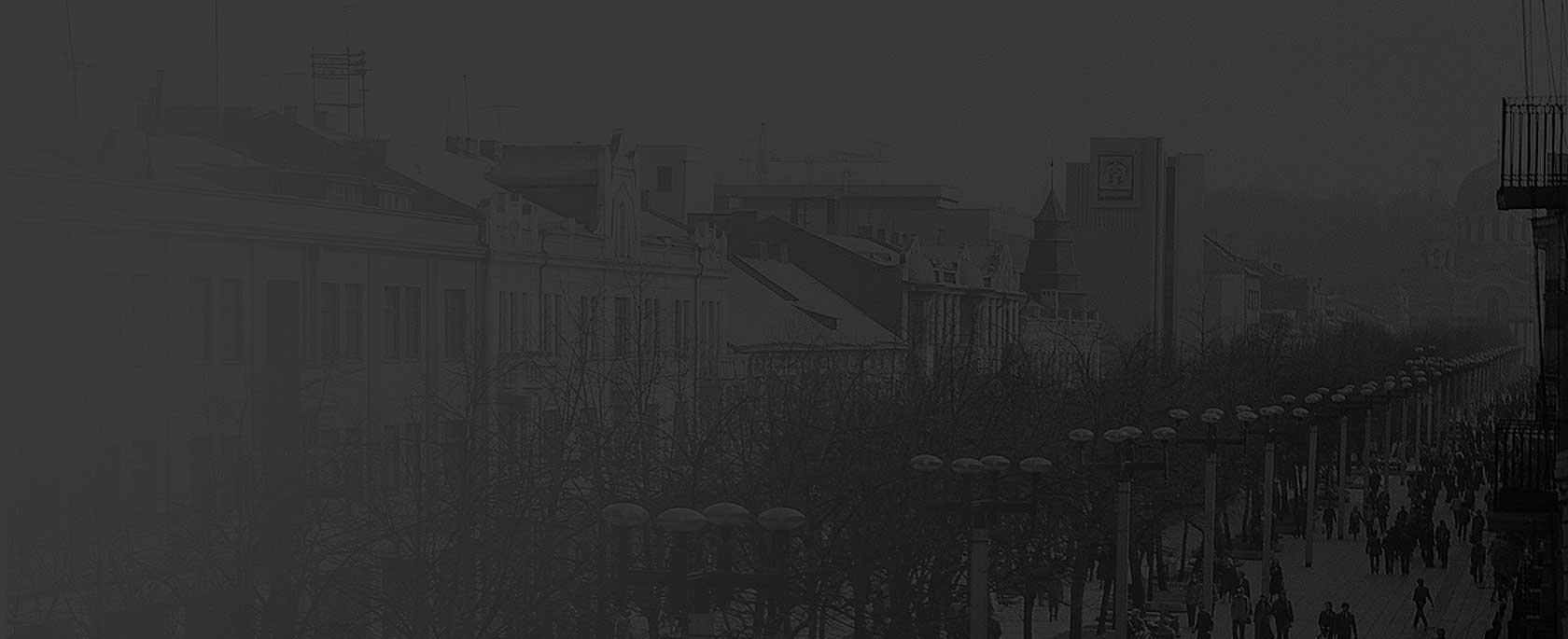
Our memory is framed by spatial reference points: places, sites, buildings, and streets give us our bearings and enable us to anchor and order our memories. So, the material alteration of these places can lead to the substantial modification of our memories, and even their disappearance.Post your memory here